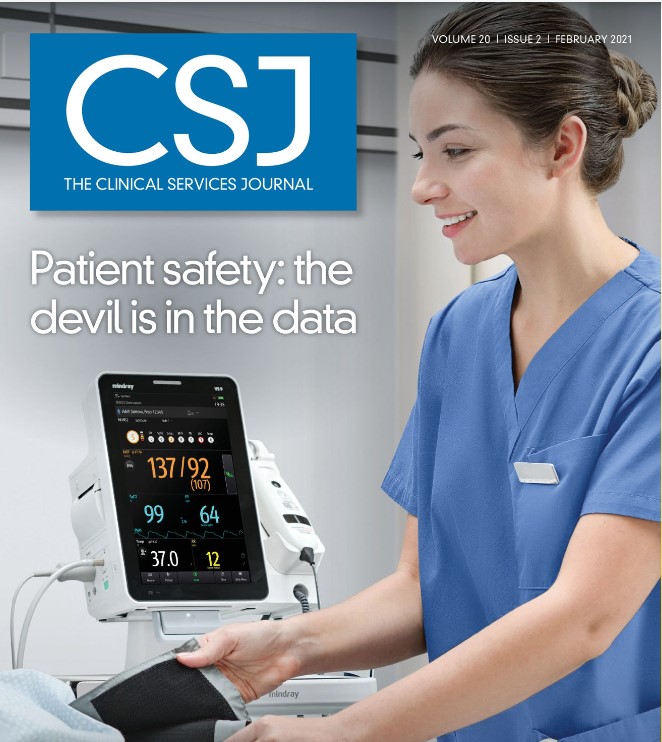With the recent announcement from Matt Hancock about reducing bureaucracy and the publication of the consultation document; ‘Busting bureaucracy: empowering frontline staff by reducing excess bureaucracy in the health and care system in England’[i], the time is ripe to look at how managing data more efficiently and applying the experiences of high reliability organisations can have a dramatic impact on patient safety.
Phil Taylor, Chief Product Officer at RLDatix explains.
The CQC is taking an in-depth look at how health and care services work together and how they can evolve in order to meet people’s needs and improve outcomes for all concerned. In doing so, patient safety is being pushed firmly to the top of the agenda.
As eloquently argued in ‘Still Not Safe’ by Robert L. Wears and Kathleen M. Sutcliffe, the modern patient safety movement (now in its third decade) has yet to realise its potential. They argue that for the potential to be realised, healthcare has to embrace the expert process and knowledge of safety science. To quote: “change will require health professionals to … develop truly substantive and equal co-partnership with safety scientists”.
The identification of opportunities to learn and improve safety is a critical facet of safety processes and is core to successfully implementing 3 of the 5 characteristics of high reliability[ii]. Healthcare is a classic example of a potentially high reliability industry, with its hyper-complexity, tight interdependence between different departments for patient outcomes, multiple levels and hierarchies for decision making, and the requirement for fast, emergency action often in compressed timescales with critical outcomes that can be a matter of life and death.
Safety has always been a key concern and there have been numerous investigations and reports after certain scandals. All of these highlight that the focus on opportunities to improve patient safety is often overlooked, a fact acknowledged and something the CQC is looking to address in its latest strategic consultation paper[iii].
This lack of investment is not, we believe, due to a lack of commitment, but due to the challenge of being able to show that investment in one area will not have a greater detrimental impact on other areas of care.
Data is where the answer to this problem will be found.
Managing Data – Not as Easy as it Sounds
A long-standing, key global strategy for improving healthcare quality and reducing the high cost of patient harm has been to leverage the power of big data to identify opportunities for improvement, that would be expensive and difficult to track and manage through human analysis alone.
A move away from paper-based records is an essential step in this journey, and something for which the NHS as a whole has numerous targets. Digital transformation will bring many benefits which are already being seen in other industries such as financial services, aviation and utilities. In reaching for these benefits, we as an industry should look to learn from the early experiences of these other sectors. We have seen that a naively executed big data strategy can be incredibly damaging to the performance of organisations and, given the complexity of modern health care systems, making the same mistakes could cause significant harm.
Unlocking the value of data, by connecting the expert insights stored in incident reporting solutions with other healthcare data systems (like EHRs), will enable healthcare organisations to track insightful and actionable patient safety data. A case in point is the example we discuss in more detail later, where increased admissions in ICU can lead to a corresponding increase in the instance of pressure sores. Monitoring the instance of one, alerts us to prepare for the other. This jump forward in technology, combined with a high reliability culture, will allow organisations to systematically review and analyse their implementation and iterative adjustment of medicines, healthcare tools, procedures and practices to support improved care.
The good news is that this is not a new idea!
Getting it Right First Time
The Getting It Right First Time (GIRFT) programme aims to bring about higher-quality care in hospitals, at lower cost. It uses national data to identify variations and outcomes. It shares that data with all those concerned with a service – not only clinicians, but also clinical and medical directors, managers and chief executives – and monitors the changes that are implemented.[iv]
A core and essential element of the GIRFT program, in their own words; “Importantly, GIRFT is led by frontline clinicians who are expert in the areas they are reviewing. This means the data that underpins the GIRFT methodology is being reviewed by people who understand those disciplines and manage those services on a daily basis.” We have learned from the high reliability movement that this type of approach is essential to success when looking to improve organisational procedural governance and an organisation’s risk profile – something that Governance, Risk and Compliance (GRC) programs in most organisations look to achieve.
In fact, for an organisation to properly support high reliability principles the GIRFT program should be viewed as an expert support team to be used with safety scientists and in-house expert teams. We believe that each participating organisation should have processes embedded in systems that support the effective and consistent investigation of any area of interest, however these are identified, prioritised and sponsored.
In considering this strategy we need to remember Peter Drucker’s words “Culture eats strategy for breakfast”.
Culture, Safety and why Organisations Need to be Better at Listening
A major survey of UK doctors published in late 2018[v] revealed that most feel they work in a dangerous and toxic environment with a blame culture that jeopardises patient safety and discourages learning and reflection.
Previous research indicates that high levels of under-reported patient safety incidents is a clear indicator of poor culture where a system designed to be one of listening and learning is seen as a system of blame, fault identification and regulatory burden. Two of the key attributes of high reliability organisations[vi] is that they are sensitive to operations and defer to expertise. Incident reporting is a key tool in listening to the experts, ie. the clinicians and people on the frontline who may not have the most seniority, but have the most in-depth knowledge of the processes involved in the care being provided.
In a high reliability healthcare organisation everyone is constantly aware of how processes and systems affect patient care and, what is, and what isn’t working. This focused attention on processes leads to accurate information to support decision making and to introduce or amend processes where required. Very few patient safety incidents are caused solely by acts or omissions of individual staff. High quality investigations often reveal system issues that need be addressed to prevent similar incidents recurring in the future. However, if staff fear the response to reporting a patient safety incident could be reprimand or blame, this can lead to incidents going unreported. This results in difficulties in analysing and rectifying issues, ultimately increasing the likelihood of similar incidents occurring in the future.
Safety reporting systems connect expert carers and specialists with organisational leadership, delivering the insights required to develop a detailed understanding of organisational behaviour and its impact on safety outcomes for patients and operational efficiencies.
The Importance of being ‘An Organisation with a Memory’
Learning from the past is the holy grail of patient safety. A key to achieving this goal is to banish information silos, ensuring that opportunities for developing insights into improving patient care are clearly identified, centralised and triaged. Thereby supporting the flow of information through the entire learning cycle.
By taking a platform approach, whereby best of breed solutions are connected to provide a gateway to multiple systems that all feed each other, this information can create a transparent learning information system. Providing not just the memory but also the nervous system to help the organisation to learn, develop and apply intelligence as a single high reliability focused entity.
Adopting High Reliability Theory
High reliability culture has been proven to have significant and tangible benefits. Following NHS reforms to create a culture of openness and transparency, research found that open culture was indeed associated with lower mortality rates in hospitals. This approach is encapsulated by ‘Communication and Optimal Resolution’ (CANDOR) processes. Generally, the CANDOR process begins with identification of an event that involves harm and proceeds through response and disclosure, through investigation and analysis, to final resolution.[vii]
To support safe outcomes the gathering and analysis of data needs to be targeted at the correct areas and measures. Research[viii] has shown that the three major components in encouraging a safety culture are;
- a just culture
- a reporting culture, and
- a learning culture
What makes a Just Culture?
NHS England and NHS Improvement have published a guide that advocates a ‘just culture’. A just culture is fair treatment of staff that supports a culture of fairness, openness and learning in the NHS by making staff feel confident to speak up when things go wrong, rather than fearing blame. Supporting staff to be open about mistakes allows valuable lessons to be learnt so the same errors can be prevented.
With the five principles of FREDA (Fairness, Respect, Equality, Dignity and Autonomy on which all international human rights treaties are based) being used by the CQC to regulate health and social care services, staff should feel confident to report incidents and give open and honest feedback when responding to staff surveys. Analysis of mortality and high harm events should investigate details such as whether an event was reported earlier, communications with staff and patient or relatives was prompt, leading to an outcomes assessment. None of this is possible, if staff do not feel confident to report in full when something does go wrong.
Reporting Culture in High Reliability Organisations
High reliability healthcare organisations that have succeeded in reducing patient harm take a positive approach to reporting.
By gathering information diligently, deferring to expert opinion (specialists, safety scientists and frontline staff), and with intelligent analysis of all the data gathered, trends and causal effects can be identified. These can lead to identifying likely harm scenarios before they happen. An example of this (referred to earlier) is the reduction of pressure sores in ICU patients.
Reporting systems need to be sufficiently sophisticated that as well as reporting volumes and sensitivity, they support investigation team structure, investigation quality and provide actionable risk centric control suggestions. The same connected system should also provide control implementations and tracking. An example of this in action – in 2018, a project was initiated by the Joint Commission Center for Transforming Healthcare in the US, where they worked with three hospitals to find root causes and solutions to pressure injuries. From May 2018 to December 2019, the hospitals saw an average 55% reduction in pressure injuries in the intensive-care unit. From January to April 2020, the hospitals reported an average 62% reduction.
Creating a Learning Culture
When introducing any new system, team engagement in the development of changes in organisation process and policy is a key to success. Involving frontline staff, listening to their views, encouraging staff advocates for new systems all help to increase engagement with new systems. Positive executive engagement in reviewing new processes and rewarding engagement further reinforces the value of new processes.
One of the key points noted early on in the Joint Commission Center for Transforming Healthcare study was that the hospitals had made improvements in the past, but were unable to sustain them. Since the project began, there has been a culture shift and a focus on education where frontline staff are now doing everything in their power to prevent pressure injuries.
Kaiser Permanente South Sacramento Medical Center[ix], a 200-bed community hospital that is taking part in the program, has sustained its nearly 60% reduction in pressure injuries even through the COVID-19 pandemic when patients in the ICU are typically hooked up to devices for weeks.[x]
Systemisation of the Process – 3 Strategies
The CQC document states; “We’ll expect to see proper processes and frameworks to show how people are being involved, and evidence to prove this is happening.” It also states that the CQC will intervene much sooner to assure itself that that services are focusing on protecting people before they experience poor care and avoidable harm. Care organisations need to have the systems in place to support staff in safe processes. They can achieve this by:
Adopting systems that are designed for the purpose of collecting data on risks, incidents, investigations, claims and feedback. Such a solution provides an audit trail, showing compliance as well as providing the means for staff to report safety concerns in a blame-free setting. Relying on spreadsheets provides no audit trail of information and no central repository for reliable data.
Choose a best in class solution from an experienced and trusted source, that has the breadth and depth to manage all information, and ensure that it is stored centrally, making it easily accessible for analysis of trends and causal effects.
Join a community for sharing best practice in patient safety, risk and quality management. Build connections across the health sector that will enable you to share experience and to learn from other organisations.
If healthcare organisations can step back, review patient safety and in so doing, ask their frontline staff what they think, they may find that providing them with a voice is a meaningful move towards better patient safety and all the benefits that that entails – for everyone.
Not just lives saved – the Benefits of Better a Safety or Highly Reliably Culture
Reducing patient harm – one of the key points in the CQC document is that stronger safety cultures should result in a vision where there is zero avoidable harm. There are other similarly compelling benefits including:
- Reducing staff burnout – Having a process that enables people to report incidents truthfully without blame or fear of recrimination not only reduces stress on staff, already heightened by COVID-19 and a key factor in staff burnout, it enables the organisation to learn from mistakes. Reducing staff burnout also means fewer staff leaving the profession and taking with them many years of valuable experience.
- Cost and resource savings – The cost of additional treatments and care for patients that have suffered avoidable harm goes into many £millions per year, and so too does the cost of legal action from victims.
Lives ARE saved
Just a small improvement in patient safety for procedures that are performed thousands of times per year means the risk is reduced and lives will undoubtedly be saved. The change in approach to pressure sores in ICU is just one such example, and one that is likely to be quite pertinent as hospitals deal with increased patients in ICU due to COVID 19.
Phil Taylor is Chief Product Officer of RLDatix
About Phil Taylor
Phil oversees the RLDatix’s product and development strategy. For the past 14 years, he has held a number of positions within the legacy Datix organisation and has a deep knowledge of the patient safety industry. Phil holds a BA from Manchester Metropolitan University and is a Chartered Accountant.
About RLDatix
RLDatix is on a mission to change healthcare. We help organizations drive safer, more efficient care by providing governance, risk and compliance tools that drive overall improvement and safety. Our suite of cloud-based software helps organizations reduce healthcare-acquired infections, report on adverse events, and ensure patient safety learnings are deployed effectively and immediately through dynamic policy and procedure management. With over 3,000 customers in 19 countries, RLDatix software protects hundreds of millions of patients around the world. For more information, visit www.rldatix.com
[i] https://www.gov.uk/government/consultations/reducing-bureaucracy-in-the-health-and-social-care-system-call-for-evidence/outcome/busting-bureaucracy-empowering-frontline-staff-by-reducing-excess-bureaucracy-in-the-health-and-care-system-in-england
[ii]5 Principles of a High Reliability Organization (HRO) https://blog.kainexus.com/improvement-disciplines/hro/5-principles
[iii] https://cqc.citizenlab.co/en-GB/projects/cqc-s-draft-strategy-for-discussion.
[iv] https://www.kingsfund.org.uk/publications/tackling-variations-clinical-care?gclid=EAIaIQobChMIg7_Mkbey3QIVqrDtCh35ewn1EAAYASAAEgLv4PD_BwE
[v] https://www.bmj.com/content/362/bmj.k4001.full
[vi] https://blog.kainexus.com/improvement-disciplines/hro/5-principles
[vii] . https://www.ahrq.gov/patient-safety/capacity/candor/modules.html
[viii] https://www.ncbi.nlm.nih.gov/pmc/articles/PMC3053221/
[ix] https://www.centerfortransforminghealthcare.org/improvement-topics/hospital-acquired-pressure-ulcers-prevention/
This article features in the February edition of The Clinical Services Journal. A copy can be downloaded, via the App store, or you can view the article in the latest edition online by clicking on the link below:



